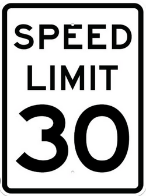Traffic Safety
Traffic safety should be a concern for everyone who uses the roads in Genesee. It is especially important when narrow or curved roads are shared by pedestrians, vehicles of various sizes, and wildlife.
Speed Limits and Tailgating
 Realistic speed limits have been set by Jefferson County on all named roads in Genesee (these are county roads; private drives are owned by Genesee Foundation and not under Jefferson County jurisdiction). Unless otherwise posted, the speed limit on county roads in Genesee is 30 mph. On county roads that are curvy and/or narrow, like Currant Drive and Bitterroot Lane, the speed limit is 25 mph.
Realistic speed limits have been set by Jefferson County on all named roads in Genesee (these are county roads; private drives are owned by Genesee Foundation and not under Jefferson County jurisdiction). Unless otherwise posted, the speed limit on county roads in Genesee is 30 mph. On county roads that are curvy and/or narrow, like Currant Drive and Bitterroot Lane, the speed limit is 25 mph.
Jefferson County does not have jurisdiction over speeds on our private drives. However, most are quite narrow and safe speeds would generally be 10 mph or less.
The speed limits have been established by the county to:
- Provide drivers the maximum permitted speed for normal conditions.
- Reduce the speed difference between vehicles. The accident rate is less when most vehicles are traveling at about the same speed.
- Mitigate the injury and damage caused by the collision of a vehicle with another vehicle, a cyclist, a pedestrian, or wildlife.
- To provide consistent and fair enforcement actions for enforcement personnel.
Speeding will not decrease your trip time by any significant or appreciable time and speeding may result in a longer trip time while the law enforcement officer finishes writing your ticket.
 Do not tailgate. It’s never a good idea, but especially not in Genesee with its prevalence of wildlife which can cross the road unexpectedly. The vehicle in front of you might have to brake suddenly to avoid a collision with a large animal crossing the road. Tailgating may increase your trip time as the driver that you are tailgating slows down to minimize the injury and damage that would occur if you collided with their vehicle.
Do not tailgate. It’s never a good idea, but especially not in Genesee with its prevalence of wildlife which can cross the road unexpectedly. The vehicle in front of you might have to brake suddenly to avoid a collision with a large animal crossing the road. Tailgating may increase your trip time as the driver that you are tailgating slows down to minimize the injury and damage that would occur if you collided with their vehicle.
Courteous Behavior
Colorado law requires vehicles to be at least 3 feet from a cyclist when passing the cyclist. If you are approaching a cyclist in your lane and another vehicle is approaching in the oncoming lane, consider slowing down well behind the cyclist until the approaching vehicle is past both you and the cyclist before passing the cyclist at the required separation.
Consider applying the Colorado cyclist law (above) to pedestrians walking in the lane in which you are driving.
Consider slowing down for pedestrians or cyclists when overtaking them on a blind or sharp curve.
Be Aware of our Wildlife
Some statistics compiled in Colorado:
- 89% of all wildlife collisions occur on roads with two lanes.
- 84% of all wildlife collisions occur in good weather on dry roads.
- The average repair cost of a vehicle-deer collision is $2,800.
- Colliding with an elk at a moderate speed may cause the elk to come over the hood of the vehicle and into the windshield. Serious driver and passenger injury is likely.
To avoid deer and elk collisions:
- Stay alert, especially at dawn and dusk.
- Slow down to increase the time you have to react.
- Scan ahead and watch for movement along roadsides.
- Look for more animals after you see one animal.
- Brake. Don’t swerve. Be ready for animals to change direction.
- Use high beams at night to improve visibility but remember to dim them for oncoming vehicles. Watch for shining eyes in your headlights.
- Slow down on blind curves.
Share the Road
The following suggestions are for anyone on one or more feet or legs, and one or more wheels, no matter the motivating power source.
Pedestrians
- Walk on the edge of the road or road shoulder, facing traffic. This will help increase your visibility to drivers and increase your awareness of an approaching vehicle and any safety issues that may exist. Consider this scenario: you are walking on the wrong side of the road, near or on the roadway. You are not aware that a car is approaching behind you (it could be an electric car, or you could be involved in a conversation, or have headphones on). The driver may feel they need to swing into the other lane to safely pass you but can’t because there’s a curve ahead with limited visibility. This is a potentially dangerous situation that would be avoided if you were walking facing traffic and aware of what was happening.
- Avoid walking in the roadway. Groups should be mindful and walk single file off the roadway, if possible, when traffic from any direction approaches.
- When walking on a road with a narrow shoulder, consider stopping on the shoulder as the vehicle approaches, and waiting until the vehicle passes you before starting to walk again.
- If you are walking a dog, consider stopping and shortening the dog’s leash so that approaching drivers don’t feel they have to go into the opposing lane of traffic in case the dog walks or jumps onto the road.
- Always make sure you’re visible to drivers. This is especially important at night, in low-light conditions such as dusk or dawn or in inclement weather. Wear light-colored or reflective clothing at night and bright-colored clothing during the day.
- Stay alert and avoid distractions. Put down your phone. Smartphones and handheld electronic devices command your attention and cause you to take your eyes off the road.
- Don’t wear headphones or earbuds. Your ears will tell you a lot about what is happening around you, if you use them.
- Follow the rules. Know and follow all traffic rules, signs, and signals. This way you can properly anticipate what drivers will do. Never assume a driver will give you the right of way. Make every effort to make eye contact with the driver of a stopped or approaching vehicle before entering the roadway.
Cyclists
- Ride with the flow of traffic.
- Always make sure that you’re visible to drivers. This is especially important at night, in low-light conditions such as dusk or dawn or in inclement weather. Wear light-colored or reflective clothing at night and bright-colored clothing during the day.
- Don’t wear headphones or earbuds. Your ears will tell you a lot about what is happening around you, if you use them.
- Follow the rules. Know and follow all traffic rules, signs, and signals. This way you can properly anticipate what drivers will do. Never assume a driver will give you the right of way. Make every effort to make eye contact with the driver of a stopped or approaching vehicle before entering the roadway.
- Remember that you are considered a vehicle and that you are most likely the smallest vehicle on the road.
- Ride single file whenever possible.
Motorists
- Focus on driving. Avoid using cell phones and other personal devices.
- Keep your eye on cyclists and pedestrians and keep track of them in your rear and side mirrors. They have the right to use all the roads in Colorado unless expressly prohibited.
- When passing a bicyclist, be sure to give at least 3 feet clearance between your car and the bike. If traffic is approaching in the oncoming lane, slow down, and wait until that traffic is past you until you consider passing the cyclist.
- Consider the conditions. The posted speed limit is not necessarily a safe speed under all possible conditions.
